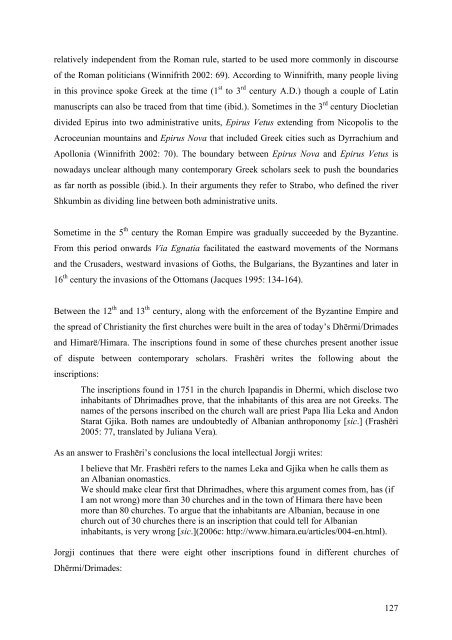university of nova gorica graduate school contested spaces and ...
university of nova gorica graduate school contested spaces and ...
university of nova gorica graduate school contested spaces and ...
Create successful ePaper yourself
Turn your PDF publications into a flip-book with our unique Google optimized e-Paper software.
elatively independent from the Roman rule, started to be used more commonly in discourse<br />
<strong>of</strong> the Roman politicians (Winnifrith 2002: 69). According to Winnifrith, many people living<br />
in this province spoke Greek at the time (1 st to 3 rd century A.D.) though a couple <strong>of</strong> Latin<br />
manuscripts can also be traced from that time (ibid.). Sometimes in the 3 rd century Diocletian<br />
divided Epirus into two administrative units, Epirus Vetus extending from Nicopolis to the<br />
Acroceunian mountains <strong>and</strong> Epirus Nova that included Greek cities such as Dyrrachium <strong>and</strong><br />
Apollonia (Winnifrith 2002: 70). The boundary between Epirus Nova <strong>and</strong> Epirus Vetus is<br />
nowadays unclear although many contemporary Greek scholars seek to push the boundaries<br />
as far north as possible (ibid.). In their arguments they refer to Strabo, who defined the river<br />
Shkumbin as dividing line between both administrative units.<br />
Sometime in the 5 th century the Roman Empire was gradually succeeded by the Byzantine.<br />
From this period onwards Via Egnatia facilitated the eastward movements <strong>of</strong> the Normans<br />
<strong>and</strong> the Crusaders, westward invasions <strong>of</strong> Goths, the Bulgarians, the Byzantines <strong>and</strong> later in<br />
16 th century the invasions <strong>of</strong> the Ottomans (Jacques 1995: 134-164).<br />
Between the 12 th <strong>and</strong> 13 th century, along with the enforcement <strong>of</strong> the Byzantine Empire <strong>and</strong><br />
the spread <strong>of</strong> Christianity the first churches were built in the area <strong>of</strong> today’s Dhërmi/Drimades<br />
<strong>and</strong> Himarë/Himara. The inscriptions found in some <strong>of</strong> these churches present another issue<br />
<strong>of</strong> dispute between contemporary scholars. Frashëri writes the following about the<br />
inscriptions:<br />
The inscriptions found in 1751 in the church Ipap<strong>and</strong>is in Dhermi, which disclose two<br />
inhabitants <strong>of</strong> Dhrimadhes prove, that the inhabitants <strong>of</strong> this area are not Greeks. The<br />
names <strong>of</strong> the persons inscribed on the church wall are priest Papa Ilia Leka <strong>and</strong> Andon<br />
Starat Gjika. Both names are undoubtedly <strong>of</strong> Albanian anthroponomy [sic.] (Frashëri<br />
2005: 77, translated by Juliana Vera).<br />
As an answer to Frashëri’s conclusions the local intellectual Jorgji writes:<br />
I believe that Mr. Frashëri refers to the names Leka <strong>and</strong> Gjika when he calls them as<br />
an Albanian onomastics.<br />
We should make clear first that Dhrimadhes, where this argument comes from, has (if<br />
I am not wrong) more than 30 churches <strong>and</strong> in the town <strong>of</strong> Himara there have been<br />
more than 80 churches. To argue that the inhabitants are Albanian, because in one<br />
church out <strong>of</strong> 30 churches there is an inscription that could tell for Albanian<br />
inhabitants, is very wrong [sic.](2006c: http://www.himara.eu/articles/004-en.html).<br />
Jorgji continues that there were eight other inscriptions found in different churches <strong>of</strong><br />
Dhërmi/Drimades:<br />
127

















